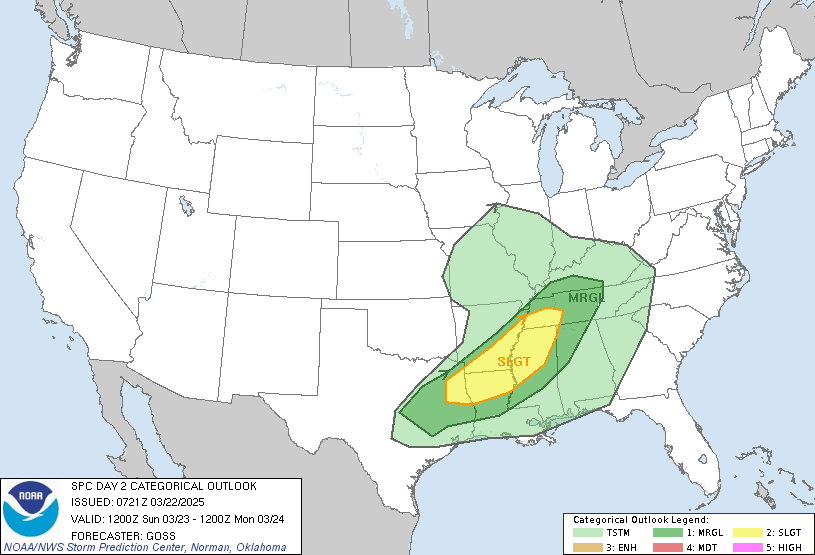LIVE MAP (ABOVE) ... SPC 0600Z Day 2 Outlook
Day 2 Convective Outlook
NWS Storm Prediction Center Norman OK
1135 PM CDT Sat Apr 01 2023
Valid 031200Z - 041200Z
...THERE IS A MARGINAL RISK OF SEVERE THUNDERSTORMS MONDAY AFTERNOON
AND EVENING ACROSS PARTS OF THE LOWER MISSOURI VALLEY...CENTRAL
TEXAS INTO SOUTH CENTRAL OKLAHOMA...AND PARTS OF NORTHERN
MISSISSIPPI INTO CENTRAL ALABAMA...
...SUMMARY...
Areas of isolated to widely scattered strong thunderstorms posing
some risk of severe weather are possible across parts of the
southern Great Plains, middle Mississippi Valley and central Gulf
Coast states Monday afternoon and evening.
...Synopsis...
It still appears that initially building large-scale mid-level
ridging across the mid-latitude eastern Pacific may reach peak
amplitude during this period. As it does, downstream amplifying
troughing likely will pivot east-northeastward toward the Rockies,
after digging inland of the Pacific coast through the southern Great
Basin and Colorado Valley vicinity. Farther downstream, mid-level
ridging is forecast to build across and east of the mid/upper
Mississippi Valley, as well as north of the persistent subtropical
ridge (centered near the Yucatan Peninsula), into the Gulf Coast
states.
Models indicate that strong surface cyclogenesis will commence
across eastern Colorado into western Kansas late Monday into Monday
night, with a broad belt of strengthening south-southwesterly return
flow across the central and southern Great Plains into the lower
Mississippi Valley. This should contribute to further
boundary-layer moistening, as far north as a stalling frontal zone
in the wake of a short wave perturbation accelerating east-northeast
of the Great Lakes region through the Canadian Maritimes. This
front is forecast to sharpen while slowly returning northward
through southern portions of the Upper Midwest and Great Lakes
region by late Monday night. The depth of the boundary-layer
moistening to the south of the front, however, may remain relatively
modest.
Meanwhile, as a mid-level low of Arctic origins lingers
near/southeast of Hudson Bay, it still appears that associated cold
surface air may begin to advance southward across portions of the
central and eastern Canadian/U.S. border vicinity.
...Great Plains/Mississippi Valley...
Beneath rising mid/upper-level heights and gradually increasing
inhibition associated with elevated mixed-layer air advecting
northward and northeastward across the region, convective potential
for Monday through Monday night remains unclear.
The dryline, which probably will retreat west-northwestward after
mixing eastward during the day, will provide one possible focus for
strong thunderstorm development across parts of central Texas into
south central Oklahoma, either late in the afternoon into early
evening or overnight. Any such activity seems likely to remain
rather isolated to widely scattered due to weak forcing, but with
any sustained thunderstorm development, the environment probably
will be conducive to supercells posing at least a risk for severe
hail.
Low-level warm advection, near a remnant outflow boundary in the
wake of a dissipating cluster of thunderstorms, may provide another
focus renewed thunderstorm development across northern Mississippi
into central Alabama. This will be hampered by the warming aloft,
but inhibition may remain weak enough through the day for isolated
to widely scattered storms, in the presence of moderately large
mixed-layer CAPE and sufficient deep-layer shear for supercell
structures.
Finally, model forecast soundings indicate that "loaded gun" type
thermodynamic profiles may develop to the immediate north of the
stalling/northward advancing surface front across northeastern
Kansas and northern Missouri into west-central/central Illinois.
This might support periodic development of at least isolated storms
capable of producing severe hail, aided by forcing for ascent
supported by low-level warm advection.
..Kerr.. 04/02/2023
Read more CHECK UPDATE ZOOM GRAPHIC
http://dlvr.it/SlsGDb
Windy.com Temps | Gusts | WU KORD KPWK |
CLICK for this month's BIG night sky ... | RADAR FULL MAP SCREEN |
|---|
MOBILE DEVICE? Turn sideways. Weather conditions directly above are near Lakefront. Top tabs refer to O'Hare (official).
Archives for the SPC Convective Outlook are updated daily (approximately) with a live map at the beginning of each article. Follow the link at the end of the article to check for current updates on the NOAA/NWS Storm Prediction Center website. Also, see Archives for Chicago's hourly weather data on CARDINAL NEWS Magazine.
CONVECTIVE | TORNADO | WIND | HAIL
O'Hare International Airport KORD
(Arlington Heights South)
Chicago Executive Airport KPWK
(Arlington Heights North)
Sunday, April 2, 2023
SPC Apr 2, 2023 0600 UTC Day 2 Convective Outlook
SUNRISE AND SUNSET TIMES IN UTC (if you're not logged in to Google)
CHICAGO UTC-6 during CST (Central Standard Time, e.g., winter)
CHICAGO UTC-5 during CDT (Daylight Savings Time, e.g., summer)
CHICAGO UTC-6 during CST (Central Standard Time, e.g., winter)
CHICAGO UTC-5 during CDT (Daylight Savings Time, e.g., summer)





















